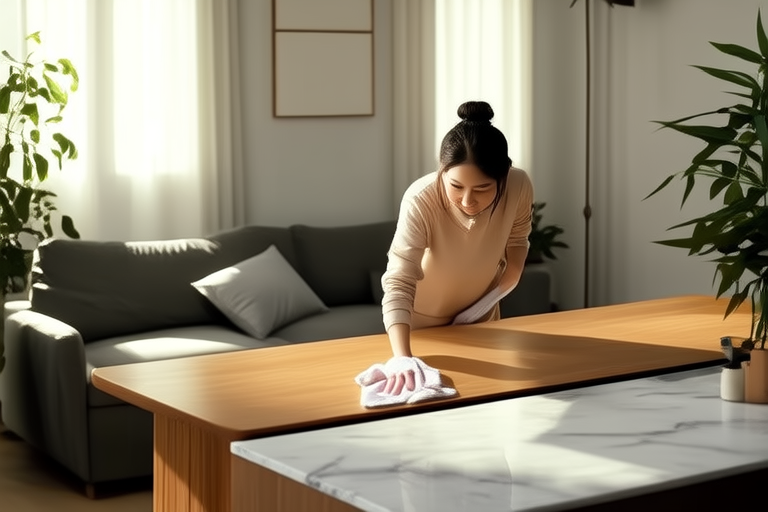Why Regular Home Surface Cleaning is Crucial for Maintaining Indoor Air Quality
Introduction: The Invisible Threats in Your Home
Indoor air quality (IAQ) is often overlooked, but it plays a critical role in our health and well-being. We spend the majority of our time indoors, yet many are unaware of the pollutants that can accumulate in our homes. Dust, mold, pet dander, and other allergens can settle on surfaces, contributing to poor IAQ. Regular home surface cleaning is not just about keeping your space tidy; it’s essential for maintaining clean, breathable air. In this article, we’ll explore why regular cleaning is crucial, how different surfaces affect IAQ, and practical tips to improve your home’s air quality.
Understanding the Impact of Surfaces on Indoor Air Quality
Dust and Allergens Accumulation
One of the most common pollutants found in homes is dust. It may seem harmless, but dust particles can carry allergens like pollen, mold spores, and pet dander. These allergens can irritate respiratory systems, especially for those with asthma or allergies. By regularly cleaning surfaces, you can significantly reduce the amount of dust and allergens floating in the air.
Mold Growth on Moist Surfaces
Moisture is a breeding ground for mold, which can thrive in damp areas like bathrooms, kitchens, and basements. Mold spores can become airborne and exacerbate respiratory issues. Regularly cleaning and drying these surfaces can prevent mold growth and improve IAQ.
Pet Dander and Other Biological Contaminants
If you have pets, their dander and fur can accumulate on surfaces, contributing to poor air quality. Additionally, biological contaminants like bacteria and viruses can linger on frequently touched surfaces, posing health risks. Proper cleaning helps eliminate these contaminants and reduces the risk of infection.
Effective Cleaning Strategies for Different Surfaces
Hard Surfaces: Countertops, Floors, and Walls
Hard surfaces are relatively easy to clean, but they require attention to detail. Use a microfiber cloth or mop to trap dust and dirt instead of spreading it around. For countertops, use a mild detergent and warm water. For floors, consider using a vacuum cleaner with a HEPA filter to capture small particles. For walls, wipe down with a damp cloth and a gentle cleaner.
Soft Surfaces: Carpets, Curtains, and Upholstery
Soft surfaces like carpets and curtains can trap dust, allergens, and other pollutants. Regular vacuuming with a HEPA filter is essential for these surfaces. For upholstery, use a vacuum attachment or consider professional cleaning services every few months. Washing curtains and drapes can also help remove accumulated dust.
High-Touch Areas: Doorknobs, Light Switches, and Remote Controls
High-touch areas are breeding grounds for germs and bacteria. Disinfect these surfaces regularly with a mixture of water and vinegar or a commercial disinfectant. Pay special attention to doorknobs, light switches, and remote controls, as they are frequently touched by multiple people.
Practical Tips to Improve Indoor Air Quality
Create a Cleaning Schedule
Developing a consistent cleaning schedule ensures that all surfaces are regularly maintained. Aim to clean high-traffic areas at least once a week and deep-clean less frequented spaces every month. This routine will help you stay on top of dust accumulation and prevent the buildup of allergens and mold.
Invest in Air Purifiers
Air purifiers can be an effective tool in improving IAQ. Look for models with HEPA filters, which can capture small particles like dust and allergens. Place air purifiers in rooms where you spend the most time, such as bedrooms and living rooms.
Increase Ventilation
Proper ventilation is crucial for reducing indoor pollutants. Open windows and doors when weather permits to allow fresh air to circulate. Consider installing exhaust fans in bathrooms and kitchens to vent moisture and odors outside.
Case Study: A Family’s Journey to Better Indoor Air Quality
Let’s take a look at the Smith family, who noticed an increase in allergy symptoms after moving into a new home. Initially, they assumed it was due to seasonal changes. However, after implementing a regular cleaning routine and investing in air purifiers, they saw significant improvements in their indoor air quality. The family now follows a strict cleaning schedule, vacuuming carpets weekly and wiping down surfaces daily. They also opened windows more frequently to increase airflow. As a result, the family members experienced fewer allergy attacks and felt more comfortable in their home.
Conclusion: Take Action for Cleaner Air
Regular home surface cleaning is a simple yet powerful way to maintain good indoor air quality. By understanding how different surfaces contribute to IAQ and implementing effective cleaning strategies, you can create a healthier living environment for yourself and your loved ones. Start by developing a cleaning schedule, investing in air purifiers, and increasing ventilation. Remember, small changes can lead to big improvements in your home’s air quality. Take action today to breathe easier tomorrow.
